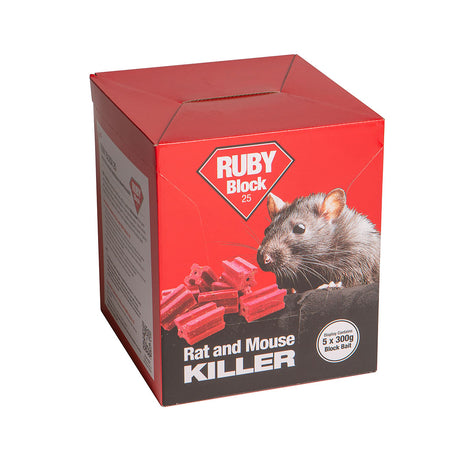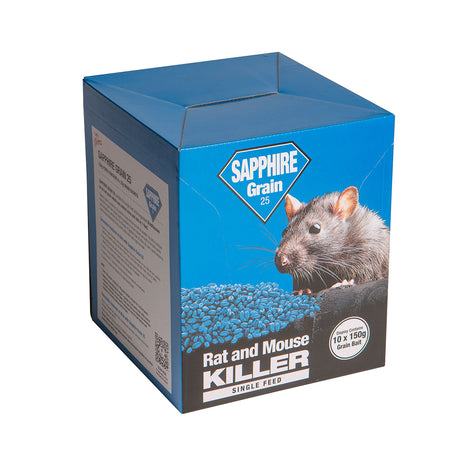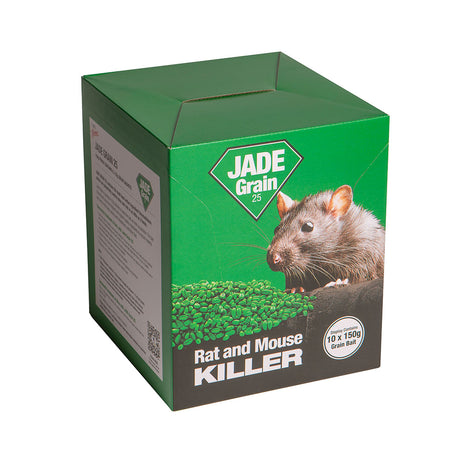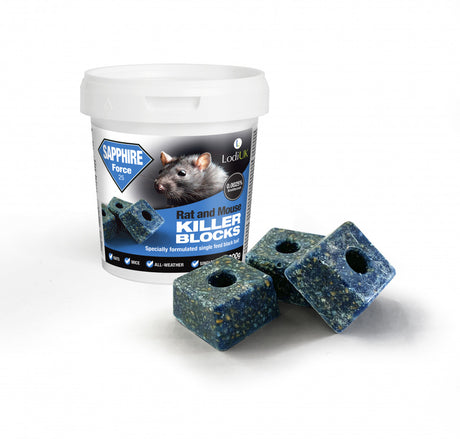Do I use Blocks or Grain?
There is no definitive answer to this, but you may consider the environment around the bait station, if it’s damp or humid, then grain baits may spoil easily, and become mouldy, but mice tend to prefer grains as this is generally what they would forage in the wild.
Grain can also be easily carried away from the bait station by the rats, and some may be spilled, which may get eaten by other non-target animals, such as your chickens.
Blocks would be preferred by Rats and they are easy to secure as they usually have a hole in them to allow this.
Visually you can easily see how much has been eaten off the block.
What is the best active ingredient?
Difenacoum: This is one of the earliest Generation anticoagulant rodenticides, introduced over 50 years ago.
It functions as a multi-feed bait, meaning that a rat or mouse must visit it multiple times over several days to ingest a lethal dose. Consequently, it may take a bit longer to resolve your issue. Multi-feed characteristic promotes family feeding among rats. As they feed, other rats observe this, which encourages them to feed as well.
Dogs and chickens must consume nearly their own body weight to have a 50% chance of death, cats however need to ingest almost double their body weight. This is generally more potent to Mice than Rats. This is a good first choice in more sensitive areas where pets, animals, chickens and children be frequent.
Bromadiolone: A second-generation anticoagulant, this active ingredient resembles Difenacoum, but its twice as effective against rats whilst still classified as a multi-feed bait. It works by preventing the blood from clotting. It is significantly more potent than Difenacoum when ingested by cats and dogs. Jade Grain can potentially kill rats and mice in as little as 2 feeds.
Brodifacoum: This is by far the most effective against rats and mice but it is also considerably more toxic to non-target species such as birds and dogs, this should be your last choice after other anticoagulants have failed. It is highly potent with a quick knockdown effect
What should I consider before laying bait down?
Have a planned approach
Conducting a comprehensive assessment of the infested area is a crucial step to ensure success before starting any rodenticide treatment.
It is important to identify environmental modifications that can be made to lessen the appeal of the area to rodents for implementation following the treatment. Typically, this includes securing the area against rodents, removing waste and weeds that offer shelter and concealment. However, the area should not be cleaned up prior to treatment, as this would disrupt the rodent population and complicate the acceptance of bait.
Food sources, such as spilled grain, should be removed and any food sources covered.
Rodenticide baits should only be used for as long as is necessary to achieve satisfactory control.
Anticoagulant bait should typically control the problem within 35 days. If activity persists beyond this period, identify and record the cause. Consider using a stronger anticoagulant if bait consumption continues without effect. If bait consumption is low relative to the size of the infestation, consider relocating the bait points, switching to a different bait base, and making environmental adjustments.
Record quantity of bait used and where it’s placed
Create and keep a site plan or location list that marks important areas to watch.
Maintain a record of bait points and amounts during treatment. Note activity at each point, including missing or disturbed baits.
Responsible rodenticide users should record bait points and remove uneaten bait at the end of treatment to protect wildlife.
Use enough baiting points
Users should follow label instructions on the size and frequency of bait points, as well as recommendations on how often and how many times to visit the site.
Using enough bait stations allows for effective rodent control and reduces the time needed for treatment. This method also lessens the risk of non-target animals being exposed.
Collect and dispose of rodent bodies
Rodents that have died might have rodenticides in their bodies, which pose a risk to wildlife, predators and scavengers that consume them.
Regular searches for rodent bodies should be conducted both during and after the treatment period. Bodies may be found for several days after rats have consumed the bait, and rats might die up to 100 metres or more away from the baited site.
Follow the label instructions to remove and dispose of rodent bodies safely.
Never leave bait exposed to non-target animals and birds
Ensure bait is protected to avoid accidentally poisoning other animals. Use natural materials when possible.
Bait stations should be suitable for the current conditions. They must allow rodents to access the bait while minimizing risks to non-target species and preventing interference by unauthorized persons. Additionally, they should protect the bait from dust or rain. Their design, construction, and placement should minimize any possible interference.
Always inspect bait regularly
If the risk assessment or treatment records suggest multiple visits are needed, they should occur as frequently as necessary. In some cases, daily inspections might be required.
At each visit, replenish baits as per the product label instructions and thoroughly search to ensure the removal and safe disposal of bodies and any spilled bait. Maintain records of these visits.
Do not leave bait down after treatment.
Bait left after treatment may contaminate wildlife.
After treatment, update records to indicate the infestation is controlled and all reasonable steps have been taken to ensure the site is free of rodenticide bait.
Professional pest controllers are the standard bearers for stewardship best practice. It will be second nature to demonstrate this by considering the risk hierarchy, as outlined in the CRRU Code of Best Practice, whereby second generation anticoagulants are not the first resort but only after all less risky options have been explored.
A Professional should be advising you as their client, against ‘just-in-case’ permanent baiting and setting a good example consistently to colleagues and clients, however in some cases you may decide to control the vermin yourself.
To enable you to do this without the required certification there are a range of rodenticides designed for amateur use, but they come with the restriction that they must only be used in and around buildings in a tamper resistant bait station.
We recognise it’s still a complex choice, there are so many to choose from out there.




